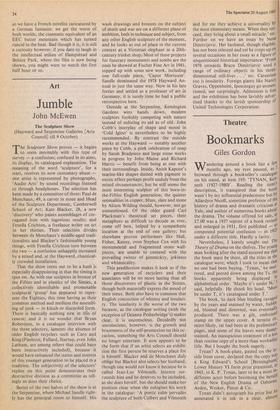Art
Jumble
John McEwen The Sculpture Show (Hayward and Serpentine Galleries [Arts Council] till 9 October)
rr he Sculpture Show proves — it begins 1 to seem inevitably with this type of survey — a confusion; confused in its aims, its display, its catalogued explanation. The meaning of the word 'sculpture', for a start, receives its now customary abuse one artist is represented by photographs, 'Audio Arts' by sound recordings listened to through headphones. The selection has been made by a committee of three: Paul de Monchaux, 49, a carver in stone and Head of the Sculpture Department, Camberwell School of Art; Kate Blacker, 28, a new 'discovery' who paints assemblages of cor- rugated iron with ingenious results; and Fenella Crichton, a freelance writer on art in her thirties. Their selection divides between de Monchaux's middle-aged tradi- tionalists and Blacker's fashionable young things, with Fenella Crichton torn between the two — a confusion unhappily increased by a mixed and, at the Hayward, chaotical- ly crowded installation. That the show turns out to be a hash is especially disappointing in that the timing is spot on. As with our sculptors in bronze of the Fifties and in plastics of the Sixties, a collectively identifiable and promotable sculptural 'group' has appeared to repre- sent the Eighties, this time having as their common method and medium the assembl- ing of junk — in kitsch or discarded form. There is basically nothing new in this of course; and it is no wonder that Bryan Robertson, in a catalogue interview with the three selectors, laments the absence of older English recyclers such as Caro and King (Paolozzi, Fullard, Startup, even John Latham, are among others that could have been instructively included), because it would have enhanced the status and interest of this younger generation to be placed in a tradition. The subjectivity of the selectors' replies on this point demonstrates their destructive division as a committee as tell- ingly as does their choice. Better of the two halves of the show is at the Serpentine, where Michael Sandie right- ly has the principal room to himself. His wash drawings and bronzes on the subject of death and war are on a different plane of ambition, both in technique and subject, from any other English sculpture of the moment, and he looks as out of place in the current context as a Victorian elephant in a 20th- century trinket shop. Most of these projects for funerary monuments and tombs are the ones he showed at Fischer Fine Art in 1981, topped up with some new work, including one full-scale piece, 'Caput Mortuum'. Sandie dominated the 1978 Hayward An- nual in just the same way. Now in his late forties and settled as a professor of art in Germany, it is surely time he had a public retrospective here. Outside at the Serpentine, Kensington Gardens wins hands down, modern sculptors foolishly competing with nature instead of enlisting its aid as of old. John Cobb's interplay of shape and mood in 'Cold Igloo' is nevertheless to be highly recommended. By contrast the outside works at the Hayward — notably another piece by Cobb, a pink celebration of soap by Sarah Bradpiece and large stone works in progress by John Maine and Richard Harris — benefit from being at one with their surroundings. Inside, Anish Kapoor's marine-like shapes dusted with pigment to exotic effect perhaps profit unduly from the mixed circumstances, but he still seems the most interesting sculptor of this born-in- the-Fifties English generation; the quieter sensualities in copper, bi-ass, slate and stone by Alison Wilding should, however, not go unmentioned. Of the older guard Carl Plackman's theatrical set pieces, their metaphors as difficult to decode as ever, come off best, helped• by a sympathetic location at the end of one gallery; but elsewhere proven performers like Hall, Fisher, Kenny, even Stephen Cox with his monumental and fragmented stone wall- pieces, are unable to contend with the prevailing twitter of gimmickry, jokiness and whimsicality. This predilection makes it look as if the new generation of recyclers and their associates will be no more lasting than all those discoverers of plastic in the Sixties, though both materially express the mood of their times. Both also have in common that English concoction of whimsy and insulari- ty. The insularity is the worse of the two because, as the catalogue writing (with the exception of Deanna Petherbridge's) makes clear, it is unconscious. Decidedly not unconscious, however, is the growth and brazenness of the self-promotion on this oc- casion, something the Arts Council should no longer entertain. It now appears to be the form that if an artist selects an exhibi- tion the first person he reserves a place for is himself. Blacker and de Monchaux duly oblige but Blacker also selects her husband, though one would not know it because he is called Jean-Luc Vilmouth. Interest sur- rounds him and he deserves to be included, as she does herself, but she should make her position clear when she eulogises his work in the catalogue: 'A poetic calm pervades the sculpture of both Culbert and Vilmouth and for me they achieve a universality by the most elementary means. When they suc• ceed, they bring about a small miracle.' etc. Further on we have an essay by Nena Dimitrijevic. Her husband, though eligible, has not been selected and yet he crops up on several occasions in her essay as a figure of unquestioned historical importance: 'From 1976 onwards Braco Dimitrijevic used a range of ordinary objects in his three- dimensional still-lives . .' etc. Careerism too is insularity. Foreign giants like NancY Graves, Oppenheim, Ipousteguy go unmen• tioned, not surprisingly. Admission is free and the exhibition has been lavishly adver- tised thanks to the lavish sponsorship of United Technologies Corporation.


































 Previous page
Previous page